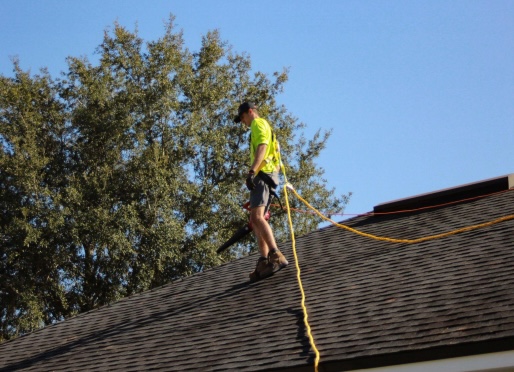Understanding the Process of a Roof Replacement

Roof replacements are crucial to maintaining the structural integrity of your home and ensuring that it remains comfortable, safe, and energy-efficient. However, before you embark on a roof replacement, you’ll want to be familiar with the process, the various material options, and the estimated costs involved. In this article, we will provide you with an in-depth understanding of the roof replacement process so that you can make informed decisions when it’s time to replace your roof. Keep reading to learn more.
Assessing the Need for a Roof Replacement
Before you decide to replace your roof, it’s essential to have a thorough assessment to determine whether a replacement is necessary. A professional roofing contractor or home inspector can help in this regard by examining the roof’s overall condition, including the shingles, flashing, gutters, and other essential components. They’ll also check for any issues with ventilation, insulation, and moisture buildup.
When deciding whether it’s time for a roof replacement, some key factors to consider include the age of the roof, damage from weather events, and potential hazards caused by leaks or structural weaknesses. If your roof is simply aged and showing general wear and tear, it may be time for a replacement. However, if there are only a few damaged or missing shingles, you might just need to repair rather than replace the roof entirely.
Another aspect to consider is the return on investment (ROI). A roof replacement can significantly increase your home’s resale value, so if you plan to sell your house in the future, investing in a new roof might be a wise decision. Consult a professional to determine the best course of action for your specific situation. An instant roof quote from an online roofing estimate calculator can help you get an idea of the costs involved in a roof replacement.
Choosing the Right Roofing Materials

Once you’ve determined that a roof replacement is necessary, it’s time to select the appropriate roofing materials. Roofing materials come in asphalt shingles, clay or concrete tiles, metal roofing, wood shakes, and synthetic materials.
Asphalt shingles are the most popular choice in North America due to their low cost, ease of installation, and wide array of styles and colors. However, they have a shorter lifespan compared to other materials and may not be suitable for homes in extremely hot climates. On the other hand, clay or concrete tiles offer excellent durability and fire resistance, but they can be costly and require additional support due to their heavy weight.
Metal roofing is growing in popularity because of its long lifespan, high energy efficiency, and low maintenance requirements. Another attractive option is wood shakes, which provide a natural and rustic appearance but require more maintenance than other materials.
Finally, synthetic materials like rubber, plastic, or composite roofing offer various benefits, such as durability, low weight, and resistance to impact and fire. Be sure to weigh the pros and cons of each material to find the best match for your needs and budget.
Preparing for the Replacement
Once you’ve selected the appropriate materials, it’s time to prepare for the actual roof replacement. Begin by clearing your surroundings, ensuring that the work site is free from obstacles and that your home’s interior is protected from debris and dust. You might also need to remove satellite dishes, antennas, or other fixtures from your roof.
Coordinate with your roofing contractor regarding the equipment, materials, and labor required for the project and establish a clear timeline for the completion of the work. Discuss where they will store materials, how they’ll handle waste disposal, and any precautions they’ll take to protect your plants and landscaping. Discuss payment terms and obtain a written contract to avoid any misunderstandings during the project.
Lastly, inform your neighbors about the planned roof replacement and give them advance notice of any noise or disruptions they might experience. This will help maintain good relations with your neighbors and reduce potential complaints.
Removing the Old Roof
The first step in the roof replacement process is the removal of the existing roofing materials. This involves stripping away the shingles or tiles, underlayment, and flashing. The roofing contractor’s crew will take necessary safety precautions, such as wearing hard hats, safety glasses, gloves, and other personal protective equipment (PPE), to minimize the risk of injuries.
During this phase of the project, keep your children and pets away from the worksite and be prepared for some noise and inconvenience. Depending on the size of your roof and the complexity of the project, the removal process can take anywhere from a day to a few days to complete.
Once the old roofing materials have been removed, the contractor will inspect the roof deck for any signs of damage or deterioration and make any necessary repairs to ensure a solid foundation for the new roof.
Installing the New Roof

After the roof deck has been inspected and necessary repairs have been made, the installation of the new roofing materials can begin. This process starts with laying down the underlayment, which acts as a water-resistant barrier and provides additional insulation and protection for your home. The type of underlayment used will depend on the chosen roofing material and local building codes.
The next step is to install the new shingles, tiles, or panels, working from the bottom edge of the roof and moving upward. This method ensures proper water runoff and prevents moisture from becoming trapped beneath the roofing materials. Your contractor will also install the appropriate flashing, which seals and waterproofs the joints and valleys of your roof to prevent water infiltration.
Once the roofing materials have been installed, the contractor will finalize the ventilation system and install any necessary accessories, such as ridge vents or attic fans, to optimize your home’s energy efficiency and comfort. The final step is to clean the worksite, removing all debris and disposing of it appropriately.
Inspecting the Finished Roof
After the installation is complete, conduct a thorough inspection of the finished roof to ensure that the work has been done correctly and that your home is adequately protected against the elements. Your contractor should walk you through the details of the new roof, pointing out the features and explaining the warranty terms and conditions.
Depending on your jurisdiction, you might also require a final inspection from a local inspector before the project is considered complete. This ensures that the work has been done according to local building codes and safety regulations.
Finally, keep a record of all the project documentation, including contracts, invoices, and warranty information, to facilitate any future claims or repairs if needed.
Maintaining Your New Roof

To prolong the lifespan of your new roof and prevent potential problems, regular maintenance may be necessary. Perform regular inspections to check for any signs of damage or wear and tear, such as cracked or missing shingles, damaged flashing, or gutters filled with debris. Promptly address these issues to prevent more significant problems in the future.
Additionally, ensure that your roof remains adequately ventilated and insulated, as this helps maintain proper temperature and moisture levels within your home. Consider hiring a professional roofing contractor to conduct periodic inspections and maintenance, as they have the expertise to spot potential problems and recommend suitable solutions tailored to your specific roof type.
Lastly, familiarize yourself with your roof’s warranty terms and conditions so that you know what is covered and for how long. This will help you make informed decisions about any repairs or replacements in the future.
Replacing your roof is a significant investment in your home’s long-term safety, comfort, and value. By understanding the key aspects of a roof replacement, such as assessing the need, choosing the right materials, preparing for the replacement, and conducting regular maintenance, you can ensure that your new roof provides lasting protection and satisfaction.




























